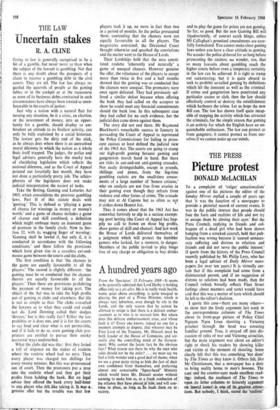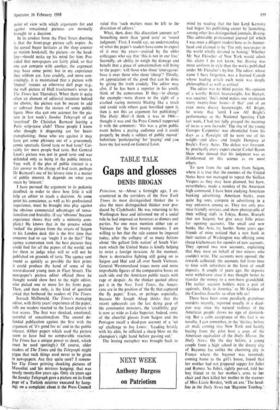THE PRESS
Picture protest
DONALD McLACHLAN
To a complaint of 'vulgar sensationalism' against one of his pictures the editor of the Sunday Mirror replied a couple of years ago that 'it was the function of a newspaper to provide a pictorial record of current events. It was in the public interest that people should face the facts and realities of life and not try to escape them by closing their eyes.' But the Press Council,- replying to friends and col- leagues of a dead girl who had been shown hanging from a wrecked aircraft, held that pub- lication was wrong because it 'caused unneces- sary suffering and distress to relatives and friends and did not serve the public interest.' (I quote from the history of the Press Council recently published by Mr Philip Levy, who has been a legal adviser of Daily Mirror news- papers for over ten years.) It is virtually cer- tain that if this complaint had come from a disinterested person, and if no suggestion of distress to relatives had been made, then the Council (which broadly reflects Fleet Street feelings about manners and taste) would have said that this was a matter of taste which should be left to the editor's decision.
I quote this case—there are many others— to show that the lively argument last week in the correspondence columns of The Times about its front-page picture of -Police Chief Nguyen Ngoc Loan shooting a Vietcong prisoner through the head was covering familiar ground. True, it strayed off into dis- cussion of rules of war and Vietcong atrocities, but the main argument was about an editor's right to shock his readers by showing killer and victim at the moment Of shooting. Some clearly felt that this was something 'not done' by The Times as they knew it. Others felt, like Mr Christiansen, that a newspaper has a duty to bring reality home to men's bosoms. The cant and the counter-cant made excellent read- ing: indeed, the readiness of The Times to open its letter columns to leisurely argument on ;moral issues'. is one of its. greatest, attrac-. tions. But nobody, I think, stated the 'realistic'
point of view with which arguments for and against sensational pictures are normally brought to a decision.
In its crudest form the Fleet Street doctrine is that the front-page picture sells copies. As the casual buyer hesitates at the shop counter or station bookstall, the picture—or the head- line—should make up his mind for him. Pro- vided that newspapers are fairly piled, so that one can compete with another, the argument may have some point; but in my experience they seldom are. Less crudely, and more con- vincingly, it is maintained that a picture with 'impact' rescues an otherwise dull page (e.g., the staff picture of Hull trawlermen's wives in The Times last Thursday). When there is quite often An element of editorial intention behind the choice, the picture can be meant to add or subtract from the stature of some public figure. How else can one account for the pic- ture in last week's Sunday Telegraph of an 'overtired' Dr Christian Barnard leaving a Paris strip-tease club? Those people I know who thought it disgusting are for heart- transplanting; those who are against it may have got some pleasure out of a gruesomely comic spectacle. Good taste or bad taste? Cer- tainly for most people bad taste. But General Loan's picture was not in good taste and was defended only as being in the public interest. Very well, if the plea of public interest is a fair answer to the charge of bad taste, perhaps Dr Barnard's use of his leisure time is a matter of public interest It depends on what you mean by 'interest.'
I have pursued the argument to its pedantic deadlock in order to show how little it will help an editor to reach a decision. At some point his conscience, as well as his professional experience, must be brought into play against the obvious commercial advantages of sensa- tionalism and brutality. (I say `obvious' because experience shows that only a minority com- plain.) He knows that in the process which `rushed' the picture from the streets of Saigon to his London desk this is the first time that someone had to say `ought I to do this?' The agency cameramen took the best pictures they could find for all the papers of the world; not for them. to judge what will or will not be published on grounds of taste. The agency sent round as quickly as possible the best prints it could produce (by hand of some of the worst-dressed young men in Fleet Street). The newspaper's picture editor offered those he thought would show best to the night editor, who picked one or more for his front page. Then, and then only, is the kind of question • asked that bothered the readers of The Times.
Iverach McDonald, The Times's managing editor, with thirty years' experience of the paper, tells me readers reacted to the Loan picture in two waves. The ,first was shocked, emotional, scornful of sensationalism. The second de- fended publication against the first with the argument of It's good for us' and in the public interest. (Other papers which used the picture seem to have had no comparable reaction. The Times has a unique power to shock, which must be used sparingly.) Of course, older readers of The Times and the Telegraph might argue that such things used never to be given in newspapers. Are they quite sure? I remem- ber The Times printing shocking pictures of Mussolini and his mistress hanging; that was nearly twenty-five years ago. Only six years ago the Sunday Telegraph gave a picture on its front Page of a Turkish minister executed by hang. tag; on a complaint about it the Press Council
ruled that `such matters must be left to the discretion of editors.'
What, then, does this discretion amount to? Something more than 'good taste' or 'sound judgment.' First, I would say, an understanding of what the paper's readers have come to expect of it over the years—assisted by the older colleagues who say that 'this is not in our line.' Secondly, an ability to weigh the damage and benefit that a .piece of sensationalism will bring to the paper: will those who shout 'courageous' have it over those who shout 'cheap'? Thirdly, an appreciation of the good that can be done by giving the truth crudely. The editor may also, if he has been a reporter in his youth, think of the cameramen. If they—to change the example—were drawn to the sight of a crashed racing motorist blazing like a torch and could with others gaze horrified upon it, then is not this an argument for publishing? The Daily Mail—I think it was in 1966— thought it was and the Press Council supported it with the comment: 'this was a grim public event before a paying audience and it could properly be made a subject of public record.' Substitute 'participating' for 'paying' and you have my last word on General Loan.



































 Previous page
Previous page